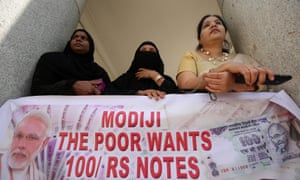Demonetisation drive that cost India 1.5m jobs fails to uncover 'black money' | World news | The Guardian
Costly banknote recall did not flush out untaxed wealth, as PM Narendra Modi had promised
 The demonetisation drive in India caught people by surprise and wiped at least 1% off the country’s GDP.
Photograph: Jagadeesh Nv/EPA
The demonetisation drive in India caught people by surprise and wiped at least 1% off the country’s GDP.
Photograph: Jagadeesh Nv/EPA
More than 99% of the currency that India declared void in a surprise announcement in 2016 was returned to the country’s banks in subsequent weeks, according to a Reserve Bank of India (RBI) report.
The figures suggest prime minister Narendra Modi’s demonetisation policy, which likely wiped at least 1% from the country’s GDP and cost at least 1.5m jobs, failed to wipe significant hordes of unaccounted wealth from the Indian economy — a key rationale for the move.
Modi shocked Indians in November 2016 when he announced on live television that all 500 and 1000-rupee notes, equivalent to about £6 and £12, would be banned in four hours’ time.
People were given several weeks to exchange their demonetised currency for new notes at banks. But new notes could not be printed fast enough, and the policy sparked a months-long currency crunch that left tens of millions of Indians cashless or standing in line for hours each day to retrieve small sums of cash.
As India’s massive informal economy reeled, Modi implored the country to give the policy time to work, arguing it would flush out untaxed wealth being hoarded by wealthy Indians, help to digitise the economy — one of the most cash-based in the world — and starve terrorists and criminal gangs of cash.
The RBI’s annual report on Wednesday found 99.3% of the money withdrawn from circulation had been returned to banks, indicating either there was less “black money” than expected, or that schemes to launder money were more successful than thought.
Palaniappan Chidambaram, a finance minister under the previous Congress-led government, said the country had paid a “huge price”.
“Indian economy lost 1.5% of GDP in terms of growth,” he tweeted. “That alone was a loss of Rs 2.25 lakh crore [2.25tn] a year. Over 100 lives were lost. 15 crore [150m] daily wage earners lost their livelihood for several weeks. Thousands of SME units were shut down. Lakhs [hundreds of thousands] of jobs were destroyed.”
Digital transactions have grown, but the RBI found the value of banknotes in circulation had also increased in the past year by 37.7%. Counterfeiters had also shifted to recreating smaller notes and were now able to replicate en masse the new 500 and 2,000-rupee notes, it said.
Gurchuran Das, an economist and author, said the positive side to the exercise was that money stashed at home had been injected into the formal banking system.
“Now all that money can be tracked and it goes into the formal economy and people who have deposited it back have bank accounts and become future taxpayers,” Das said.
“It has helped India move faster towards a digital economy. It will result in India actually skipping the branch phase of banking.
“But this was not the way to do it,” he added. “The cost to the people was high, and we lost about a year of economic growth by my estimates. And to solve the jobs problem of India you need to grow at about 8% for about 20 years.”